A Widely Tunable Three-Section DBR Lasers for Multi-Species Gas Detection
Abstract
:1. Introduction
2. Experimental Details
3. Results and Discussion
3.1. Characterization of the DBR Laser
3.2. Experimental Setup of TDLAS
4. Conclusions
Author Contributions
Funding
Institutional Review Board Statement
Informed Consent Statement
Data Availability Statement
Acknowledgments
Conflicts of Interest
References
- Bakhirkin, Y.A.; Kosterev, A.A.; Roller, C.; Curl, R.F.; Tittel, F.K. Mid-infrared quantum cascade laser based off-axis integrated cavity output spectroscopy for biogenic nitric oxide detection. Appl. Opt. 2004, 43, 2257–2266. [Google Scholar] [CrossRef]
- Kluczynski, P.; Lundqvist, S.; Belahsene, S.; Rouillard, Y.; Nahle, L.; Fischer, M.; Koeth, J. Detection of propane using tunable diode laser spectroscopy at 3.37 μm. Appl. Phys. A 2012, 108, 183–188. [Google Scholar] [CrossRef]
- Nadezhdinskii, A.; Ponurovskii, Y.; Stavrovskii, D. Non-contact detection of explosives by means of a tunable diode laser spectroscopy. Appl. Phys. A 2008, 90, 361–364. [Google Scholar] [CrossRef]
- Yang, B.; He, G.-Q.; Liu, P.-J.; Qi, Z.-M. Design of Diode Laser Sensor Based on TDLAS for Rocket Based Combined Cycle. Symp. Photonics Optoelectron. 2011, 1–4. [Google Scholar] [CrossRef]
- Durry, G.; Li, J.S.; Vinogradov, I.; Titov, A.N.; Joly, L.; Cousin, J.; Decarpenterie, T.; Amarouche, N.; Liu, X.; Parvitte, B.; et al. Near infrared diode laser spectroscopy of C2H2, H2O, CO2 and their isotopologues and the application to TDLAS, a tunable diode laser spectrometer for the martian PHOBOS-GRUNT space mission. Appl. Phys. A 2010, 99, 339–351. [Google Scholar] [CrossRef]
- Sigrist, M.; Bartlome, R.; Marinov, D.; Rey, J.; Vogler, D.; Wachter, H. Trace gas monitoring with infrared laser-based detection schemes. Appl. Phys. A 2008, 90, 289–300. [Google Scholar] [CrossRef]
- Besson, J.-P.; Schilt, S.; Thévenaz, L. Multi-gas sensing based on photoacoustic spectroscopy using tunable laser diodes. Spectrochim. Acta Part A Mol. Biomol. Spectrosc. 2004, 60, 3449–3456. [Google Scholar] [CrossRef]
- Phelan, R.; Lynch, M.; Donegan, J.F.; Weldon, V. Simultaneous multispecies gas sensing by use of a sampled grating distributed Bragg reflector and modulated grating Y laser diode. Appl. Opt. 2005, 44, 5824–5831. [Google Scholar] [CrossRef]
- Shao, J.; Han, Y.; Guo, J.; Wang, L.; Han, Y.; Zhou, Z.; Kan, R. Multigas detection using a sample-grating distributed Bragg reflector diode laser. Appl. Opt. 2013, 52, 7462–7468. [Google Scholar] [CrossRef]
- Kan, Q.; Ding, Y.; Zhao, L.; Zhu, H.; Zhou, F.; Wang, L.; Wang, B.; Wang, W. Offset Quantum-Well Method for Tunable Distributed Bragg Reflector Lasers and Electro-Absorption Modulated Distributed Feedback Lasers. Chin. Opt. Lett. 2005, 3, 455–456. [Google Scholar]
- Shinoda, K.; Kitatani, T.; Aoki, M.; Mukaikubo, M.; Uchida, K.; Uomi, K. 1.3-μm InGaAlAs Short-Cavity DBR Lasers for Uncooled 10-Gb/s Operation With Low Drive Current. IEEE Photon Technol. Lett. 2006, 18, 2383–2385. [Google Scholar] [CrossRef]
- Afzal, S.; Scholz, W.; Gready, D.; Eisenstein, G.; Melanen, P.; Vilokkinen, V.; Vallone, M.; Schnabel, F.; Reithmaier, J.P.; Montrosset, I. 1.3-μm Two-Section DBR Lasers Based on Surface Defined Gratings for High-Speed Telecommunication. IEEE Photon Technol. Lett. 2011, 23, 411–413. [Google Scholar] [CrossRef]
- Han, L.; Liang, S.; Xu, J.; Qiao, L.; Wang, H.; Zhao, L.; Zhu, H.; Wang, W. DBR Laser with over 20nm Wavelength Tuning Range. IEEE Photon Technol. Lett. 2016, 28, 1. [Google Scholar] [CrossRef]
- Han, L.H.L.; Liang, S.L.S.; Zhang, C.Z.C.; Yu, L.Y.L.; Zhao, L.Z.L.; Zhu, H.Z.H.; Wang, B.W.B.; Ji, C.J.C.; Wang, W.W.W. Fabrication of widely tunable ridge waveguide DBR lasers for WDM-PON. Chin. Opt. Lett. 2014, 12, 091402–91405. [Google Scholar] [CrossRef]
- Tilma, B.W.; Bente, E.A.J.M.; Leijtens, X.J.M.; Nötzel, R.M.; Smit, K. Design of an Integrated Electro-Optically Tuna-ble Filter for Tunable Laser Purposes. In Proceedings of the 14th European Conference on Integrated Optics (ECIO), Eindhoven, The Netherlands, 11–13 June 2008; pp. 181–184. [Google Scholar]
- Tilma, B.W.; Tahvili, M.S.; Kotani, J.; Nötzel, R.; Smit, M.K.; Bente, E.A.J.M. Measurement and analysis of optical gain spectra in 1.6 to 1.8 μm InAs/InP (100) quantum-dot amplifiers. Opt. Quantum Electron. 2009, 41, 735–749. [Google Scholar] [CrossRef] [Green Version]
- Tilma, B.W.; Jiao, Y.; Van Veldhoven, P.J.; Smalbrugge, B.; Ambrosius, H.P.M.M.; Thijs, P.J.; Leijtens, X.J.M.; Nötzel, R.; Smit, M.K.; Bente, E.A.J.M. InP-Based Monolithically Integrated Tunable Wavelength Filters in the 1.6–1.8 μm Wavelength Region for Tunable Laser Purposes. J. Light. Technol. 2011, 29, 2818–2830. [Google Scholar] [CrossRef]
- Tilma, B.W.; Jiao, Y.Y.; Kotani, J.J.; Smalbrugge, E.B.; Ambrosius, H.P.M.M.; Thijs, P.P.; Leijtens, X.J.M.; Ntzel, R.; Smit, M.K.; Bente, E.A.J.M. Integrated Tunable Quantum-Dot Laser for Optical Coherence Tomography in the 1.7 μm Wavelength Region. IEEE J. Quantum Electron. 2011, 48, 87–98. [Google Scholar] [CrossRef]
- Zeller, W.; Naehle, L.; Fuchs, P.; Gerschuetz, F.; Hildebrandt, L.; Koeth, J. DFB Lasers Between 760 nm and 16 µm for Sensing Applications. Sensors 2010, 10, 2492–2510. [Google Scholar] [CrossRef]
- O’Gorman, J.; Weldon, V.; McDonald, D.; Perez-Camacho, J.J.; Corbett, B.; Hegarty, J. Gas sensing using IR laser diode sources. In Proceedings of the Chemical, Biochemical and Environmental Fiber Sensors IX, Munich, Germany, 30 May 1997; Volume 3105, pp. 301–316. [Google Scholar] [CrossRef]
- Weber, J.-P. Optimization of the carrier-induced effective index change in InGaAsP waveguides-application to tunable Bragg filters. IEEE J. Quantum Electron. 1994, 30, 1801–1816. [Google Scholar] [CrossRef]
- Pasquariello, D.; Bjorlin, E.; Lasaosa, D.; Chiu, Y.-J.; Piprek, J.; Bowers, J. Selective undercut etching of InGaAs and InGaAsP quantum wells for improved performance of long-wavelength optoelectronic devices. J. Light. Technol. 2006, 24, 1470–1477. [Google Scholar] [CrossRef] [Green Version]
- Yu, H.; Wang, P.; Mi, J.; Zhou, X.; Pan, J.; Wang, H.; Xie, L.; Wang, W. 1.8-μm DBR Lasers with Over 11-nm Continous Wavelength Tuning Range for Multi-Species Gas Detection. In Proceedings of the 2017 Asia Communications and Photonics Conference (ACP), Guangzhou, China, 10–13 November 2017; pp. 8–10. [Google Scholar] [CrossRef]
- Zhang, T.-T.; Wei, Y.-B.; Wang, C.; Liu, T.-Y. Research of optic fiber CO concentration monitoring virtual system based on TDLAS. In Proceedings of the International Symposium on Photoelectronic Detection and Imaging 2011, Beijing, China, 24–26 May 2011; Volume 8192, p. 81922. [Google Scholar]


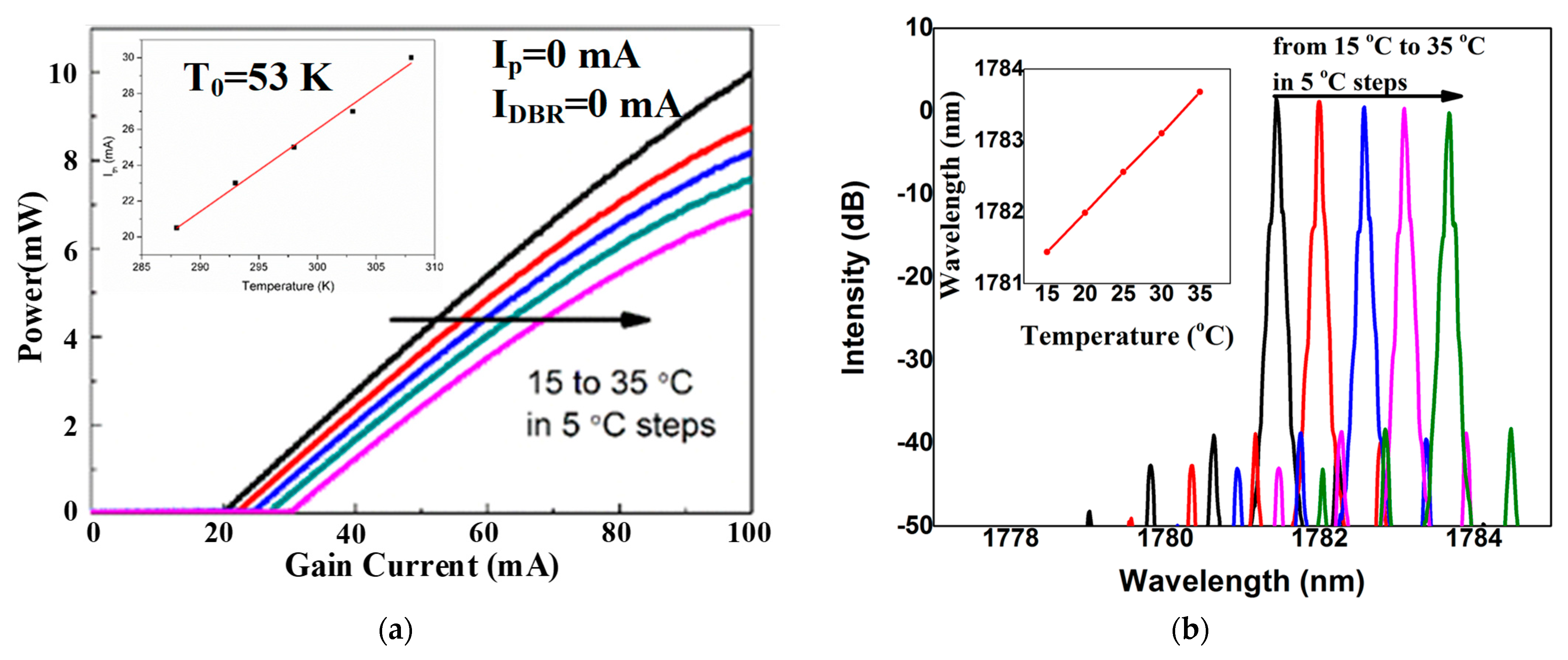
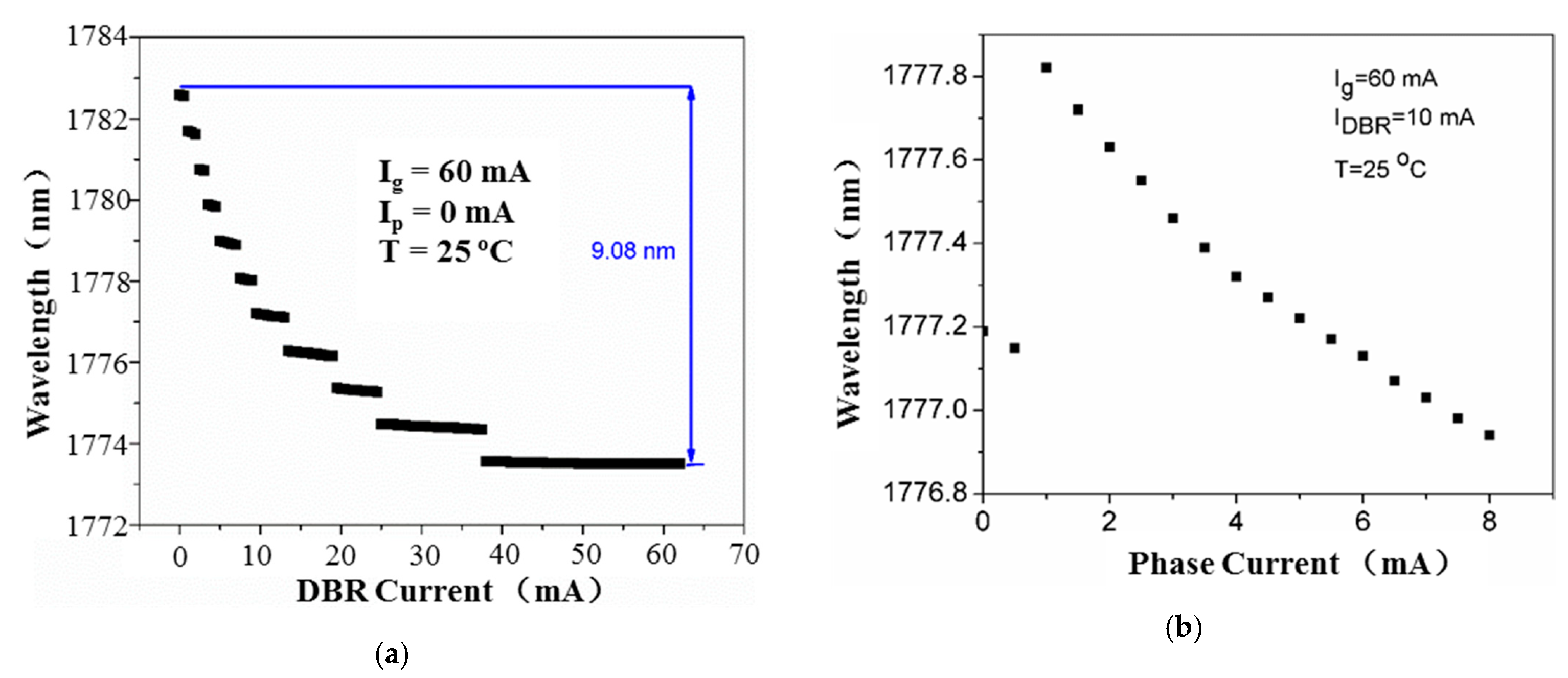
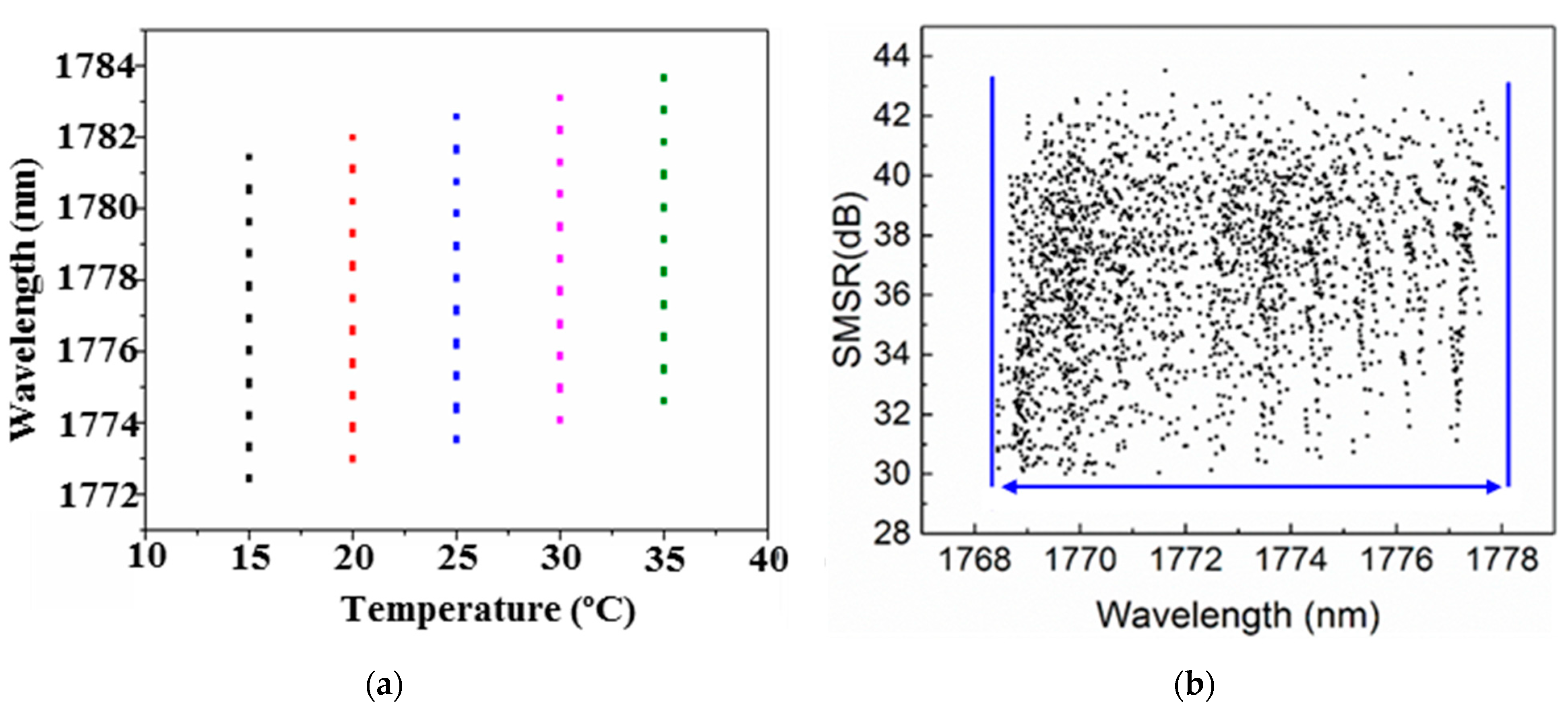
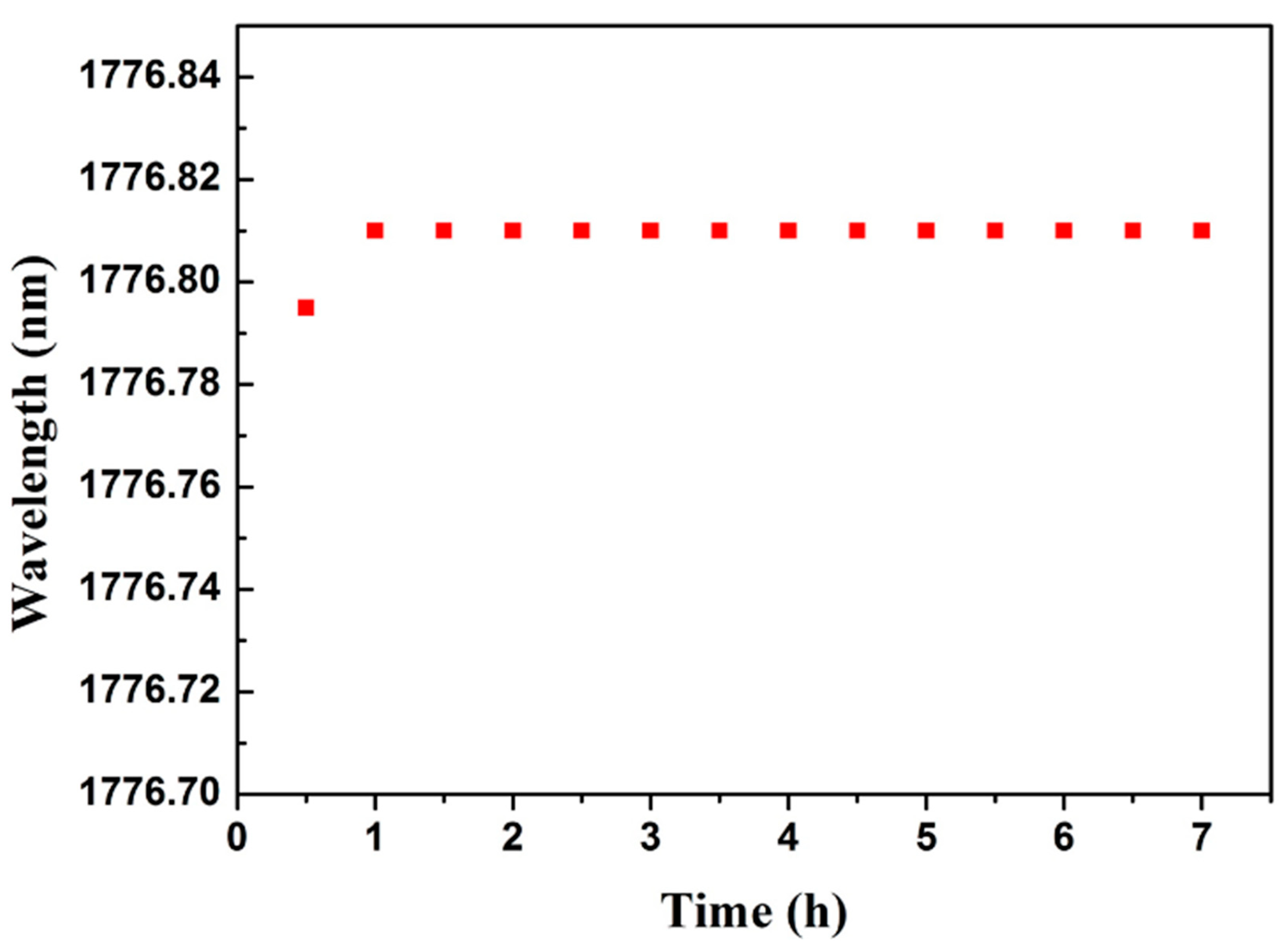

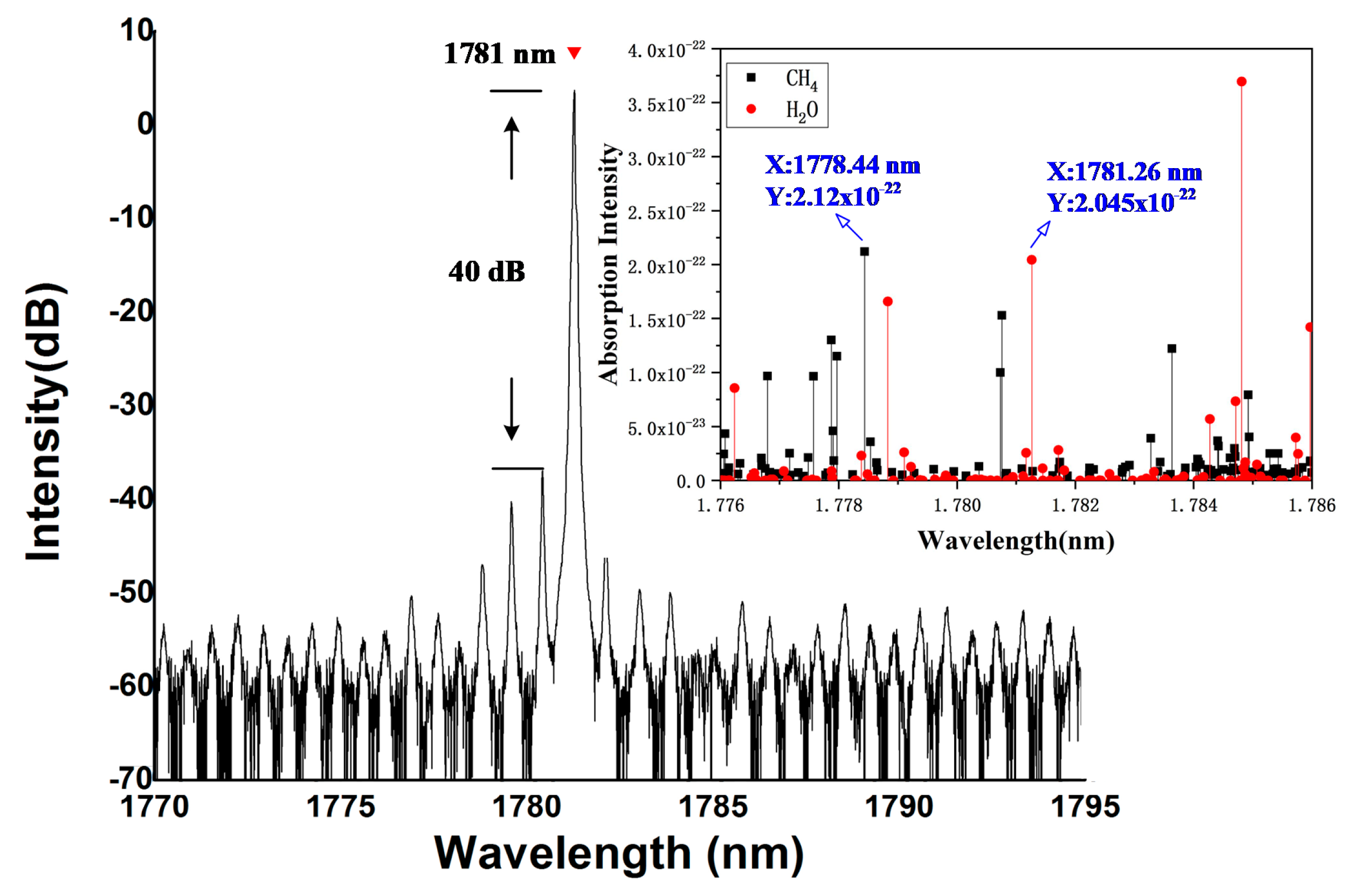
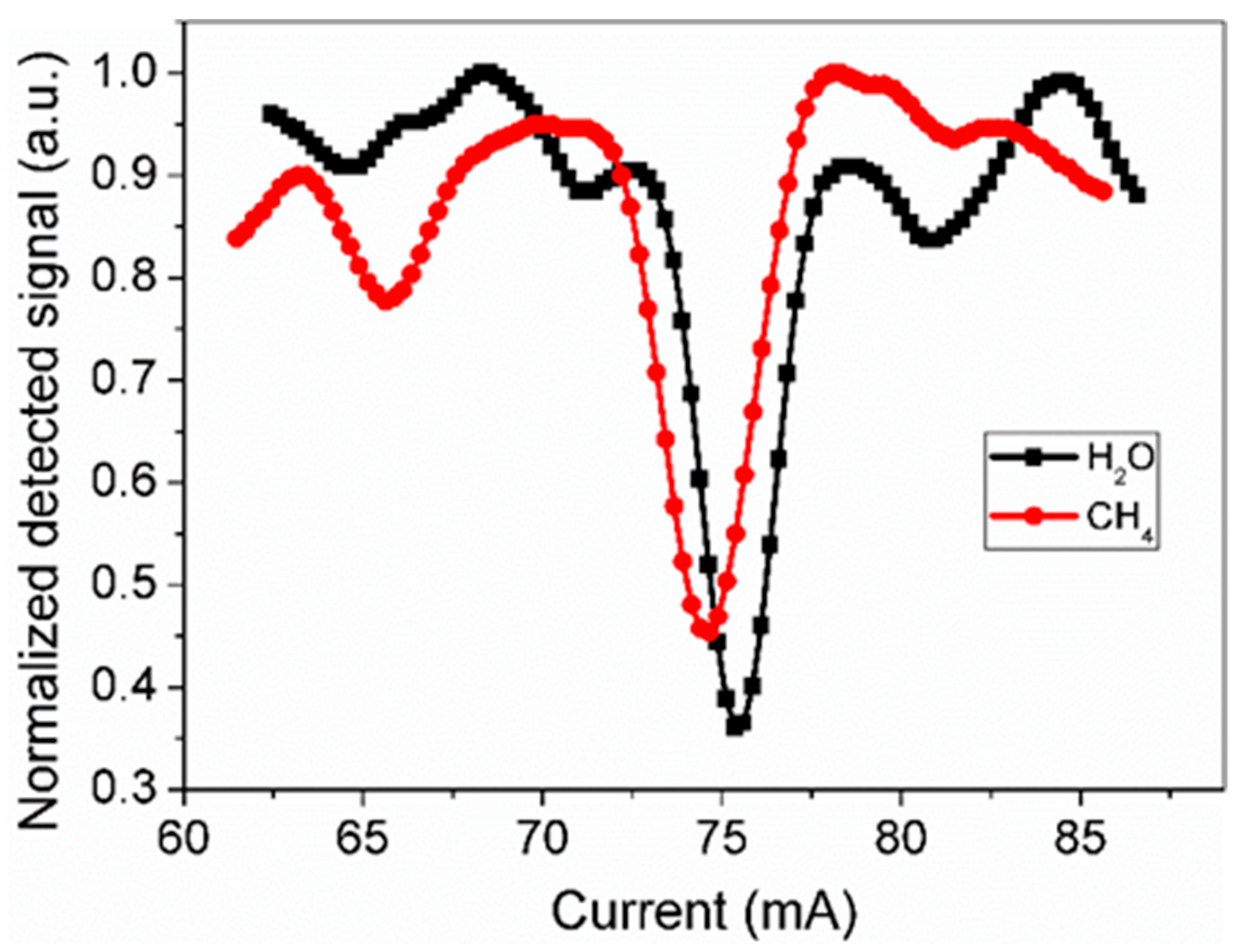
Publisher’s Note: MDPI stays neutral with regard to jurisdictional claims in published maps and institutional affiliations. |
© 2021 by the authors. Licensee MDPI, Basel, Switzerland. This article is an open access article distributed under the terms and conditions of the Creative Commons Attribution (CC BY) license (http://creativecommons.org/licenses/by/4.0/).
Share and Cite
Yu, H.; Pan, J.; Zhou, X.; Wang, H.; Xie, L.; Wang, W. A Widely Tunable Three-Section DBR Lasers for Multi-Species Gas Detection. Appl. Sci. 2021, 11, 2618. https://doi.org/10.3390/app11062618
Yu H, Pan J, Zhou X, Wang H, Xie L, Wang W. A Widely Tunable Three-Section DBR Lasers for Multi-Species Gas Detection. Applied Sciences. 2021; 11(6):2618. https://doi.org/10.3390/app11062618
Chicago/Turabian StyleYu, Hongyan, Jiaoqing Pan, Xuliang Zhou, Hui Wang, Liang Xie, and Wei Wang. 2021. "A Widely Tunable Three-Section DBR Lasers for Multi-Species Gas Detection" Applied Sciences 11, no. 6: 2618. https://doi.org/10.3390/app11062618





